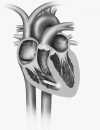Pacing Without Wires: Leadless Cardiac Pacing
- PMID: 27660571
- PMCID: PMC5024804
Pacing Without Wires: Leadless Cardiac Pacing
Abstract
Background: Worldwide, more than 700,000 pacemakers are implanted annually with more than 250,000 implanted in the United States. Since the first fully transvenous pacemaker implantations in the early 1960s, great technologic advances have been made in pacing systems. However, the combination of subcutaneous pulse generators and transvenous pacing leads has remained constant for more than 50 years. Leadless pacing systems offer an alternative to traditional pacing systems by eliminating the need for permanent transvenous leads while providing therapy for patients with bradyarrhythmias.
Methods: We discuss the 2 leadless cardiac pacemakers (LCPs), the Nanostim Leadless Pacemaker and Micra Transcatheter Pacing System, and the 1 ultrasound-powered device, the WiCS-LV, that have been studied in humans. Currently LCPs are restricted to single-chamber pacing, specifically, ventricular pacing. Dual-chamber pacing and multichamber pacing with leadless systems have yet to be studied.
Results: LCPs represent the greatest advancement in bradycardia therapy since the first transvenous pacemaker implantation more than 50 years ago.
Conclusion: Initial studies of both the Nanostim and Micra LCPs show favorable efficacy and safety results compared to transvenous pacemakers. Pending US Food and Drug Administration approval, these devices will transform our ability to provide pacing for patients with bradyarrhythmias. Future developments may allow for completely leadless single-chamber and multichamber pacing, ushering in an era of pacing without wires.
Keywords: Bradycardia; cardiac pacing–artificial; pacemaker–artificial.
Figures



Similar articles
-
Leadless Cardiac Pacemakers: Current status of a modern approach in pacing.Hellenic J Cardiol. 2017 Nov-Dec;58(6):403-410. doi: 10.1016/j.hjc.2017.05.004. Epub 2017 May 18. Hellenic J Cardiol. 2017. PMID: 28529181 Review.
-
Leadless cardiac pacing systems: current status and future prospects.Expert Rev Med Devices. 2019 Nov;16(11):923-930. doi: 10.1080/17434440.2019.1685870. Expert Rev Med Devices. 2019. PMID: 31657945 Review.
-
Leadless Pacemakers: State of the Art and Future Perspectives.Card Electrophysiol Clin. 2018 Mar;10(1):17-29. doi: 10.1016/j.ccep.2017.11.003. Card Electrophysiol Clin. 2018. PMID: 29428139 Review.
-
Leadless cardiac pacemakers: present and the future.Curr Opin Cardiol. 2018 Jan;33(1):7-13. doi: 10.1097/HCO.0000000000000468. Curr Opin Cardiol. 2018. PMID: 29045345 Review.
-
Outcomes of leadless pacemaker implantation after cardiac surgery and transcatheter structural valve interventions.J Cardiovasc Electrophysiol. 2023 Nov;34(11):2216-2222. doi: 10.1111/jce.16074. Epub 2023 Sep 20. J Cardiovasc Electrophysiol. 2023. PMID: 37727925
Cited by
-
Percutaneous solution for a frequent complication after transcatheter aortic valve replacement: A case of atrioventricular leadless pacemaker implantation after transcatheter aortic valve replacement.HeartRhythm Case Rep. 2020 Sep 24;7(1):8-11. doi: 10.1016/j.hrcr.2020.09.005. eCollection 2021 Jan. HeartRhythm Case Rep. 2020. PMID: 33505846 Free PMC article. No abstract available.
-
Innovation in Permanent Pacemaker's Implantation Technique: Trans-Axillary Approach.Cureus. 2021 Apr 12;13(4):e14436. doi: 10.7759/cureus.14436. Cureus. 2021. PMID: 33996301 Free PMC article.
-
Nanotechnology in interventional cardiology: A state-of-the-art review.Int J Cardiol Heart Vasc. 2022 Nov 18;43:101149. doi: 10.1016/j.ijcha.2022.101149. eCollection 2022 Dec. Int J Cardiol Heart Vasc. 2022. PMID: 36425567 Free PMC article. Review.
-
Advances in Wireless, Batteryless, Implantable Electronics for Real-Time, Continuous Physiological Monitoring.Nanomicro Lett. 2023 Dec 15;16(1):52. doi: 10.1007/s40820-023-01272-6. Nanomicro Lett. 2023. PMID: 38099970 Free PMC article. Review.
-
Safety and Efficacy of Leadless Pacemakers: A New Era of Pacing.J Innov Card Rhythm Manag. 2018 Jul 15;9(7):3215-3220. doi: 10.19102/icrm.2018.090701. eCollection 2018 Jul. J Innov Card Rhythm Manag. 2018. PMID: 32477814 Free PMC article. Review.
References
-
- Mond HG, Proclemer A. The 11th world survey of cardiac pacing and implantable cardioverter-defibrillators: calendar year 2009—a World Society of Arrhythmia's project. Pacing Clin Electrophysiol. 2011. August; 34 8: 1013- 1027. doi: 10.1111/j.1540-8159.2011.03150.x. - DOI - PubMed
-
- Parsonnet V, Zucker IR, Gilbert L, Maxim ASA M. An intracardiac bipolar electrode for interim treatment of complete heart block. Am J Cardiol. 1962. August; 10: 261- 265. - PubMed
-
- Udo EO, Zuithoff NP, van Hemel NM, et al. Incidence and predictors of short- and long-term complications in pacemaker therapy: the FOLLOWPACE study. Heart Rhythm. 2012. May; 9 5: 728- 735. doi: 10.1016/j.hrthm.2011.12.014. - DOI - PubMed
-
- Ellenbogen KA, Hellkamp AS, Wilkoff BL, et al. Complications arising after implantation of DDD pacemakers: the MOST experience. Am J Cardiol. 2003. September 15; 92 6: 740- 741. - PubMed
-
- Reddy VY, Knops RE, Sperzel J, et al. Permanent leadless cardiac pacing: results of the LEADLESS trial. Circulation. 2014. April 8; 129 14: 1466- 1471. doi: 10.1161/CIRCULATIONAHA.113.006987. - DOI - PubMed
Publication types
LinkOut - more resources
Full Text Sources
Other Literature Sources
